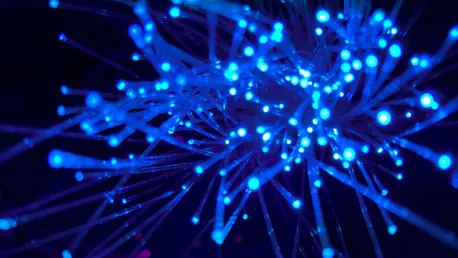The ever-growing demands for higher-speed data transfer in the machine vision industry have led to the development of new technologies and interfaces. Since its introduction in 2011, the CoaXPress (CXP) interface has stood out as a leading solution, utilizing coaxial cables to support speeds up to 12.5 Gb/s per link. While this speed was once sufficient, the increasing need for higher data transfer rates has highlighted the bandwidth limitations of coaxial-based systems. BitFlow, a brand under Advantech, is addressing these limitations by advocating for a transition to fiber-optic technology, which offers the potential for significantly higher speeds.
Meeting the Need for Speed with CoaXPress-over-Fiber
To overcome the bandwidth ceiling of traditional coaxial cables, the CoaXPress-over-Fiber (CoF) extension of the CoaXPress 2.0 specification has been introduced. This extension allows the CXP-12 protocol to operate over standard Ethernet connections, including fiber optics, enabling potential data transfer speeds of 100 or even 200 Gb/s. Fiber optic cables not only support these remarkably higher speeds but also provide immunity to electromagnetic interference (EMI), which can disrupt data transmission. As a result, the CoF extension offers technical advantages that make it a compelling alternative to the traditional coaxial-based systems.
BitFlow is at the forefront of this transition, creating innovative products designed to support the shift from coaxial to fiber optics. These products are crucial for future-proofing machine vision systems to accommodate higher camera resolutions, increased throughput, and the integration of Artificial Intelligence (AI). By transitioning to CoF, industries can capitalize on the enhanced capabilities provided by fiber optics, unlocking significant opportunities for both existing and new applications. Traditional machine vision inspections and the burgeoning Industrial Internet of Things (IIoT) stand to benefit greatly from this technological advancement.
BitFlow’s Innovations for CoaXPress-over-Fiber
One of BitFlow’s key offerings to facilitate this transition is the Claxon CoF frame grabber. This product is specifically designed to leverage fiber optic cables for CoaXPress, supporting QSFP+ compatible fiber cable assemblies. The Claxon CoF frame grabber supports single-mode fiber cables up to 120 kilometers, ensuring reliable data transmission between cameras and a PC over long distances. This capability is particularly valuable for high-bandwidth applications such as multiple linescan cameras and 3D video scientific analyses, where the demand for robust data transfer is paramount.
Another significant innovation from BitFlow is the QFi copper-to-fiber module, which supports long-distance data transmission from a single-link CXP camera to a host PC over fiber optic cables. The QFi module provides a cost-effective solution for extending CXP transmission up to 120 kilometers, addressing the needs of users requiring extended cable lengths without compromising on performance. These products exemplify BitFlow’s commitment to eliminating EMI concerns and overcoming cable length constraints while facilitating the transition to CoaXPress-over-Fiber.
Future Outlook for Machine Vision Systems
The ever-growing demand for faster data transfer in the machine vision industry has driven the development of new technologies and interfaces. Since its debut in 2011, the CoaXPress (CXP) interface has emerged as a key solution, employing coaxial cables to achieve speeds up to 12.5 Gb/s per link. Initially, this speed was adequate; however, as the need for higher data transfer rates continues to rise, the inherent bandwidth limitations of coaxial systems have become evident. To address these constraints, BitFlow, an Advantech brand, is championing the transition to fiber-optic technology. This shift not only resolves the limitations of coaxial cables but also paves the way for significantly higher speeds, transforming the landscape of data transfer in the industry. Fiber-optic technology supports much faster data transfer rates, making it a superior alternative to traditional coaxial systems, thereby aligning with the industry’s increasing demands for speed and efficiency.









